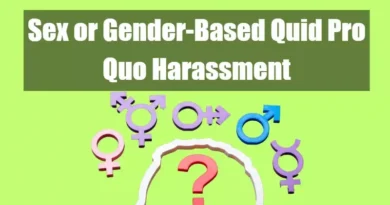Quid Pro Quo Harassment: What It Is? Know Everything
Takeaways
| Key Points |
|---|
| Definition: Quid pro quo (“Something for Something” or “This for That”) harassment involves exchanging sexual favors for job benefits or to avoid negative consequences. |
| Legal Framework: Illegal under Title VII of the Civil Rights Act of 1964 and Title IX of the Education Amendments of 1972. |
| Types of QPQ Harassment: – Explicit: Direct offers or demands for sexual favors. – Implicit: Implied threat or promise. – Coercive: Victim is forced or threatened into compliance. |
| Contexts of Occurrence: Can occur in workplaces, educational settings, housing, relationships, and politics/government. |
| Victims: Anyone can be a victim, but vulnerable groups include women, young students, people with disabilities, low-wage workers, and LGBTQ+ individuals. |
| Perpetrators: Perpetrators can include bosses, teachers, landlords, romantic partners, and political figures, typically those in positions of power. |
| Effects on Victims: Quid pro quo harassment can cause psychological, physical, financial, social, emotional, and long-term effects. |
| Identification Signs: Signs include explicit offers for job benefits in exchange for sexual favors, unwanted physical contact, threats of retaliation, and exclusion from opportunities. |
| Legal Consequences: In some cases, perpetrators can face back pay, emotional distress damages, punitive damages, and criminal charges. |
| Prevention Strategies: Establish clear policies, conduct regular training, foster a respectful workplace culture, and implement safe reporting processes. |
| Reporting Channels: Victims can report harassment internally through HR or managers, or externally through the EEOC, state agencies, or legal action. |
| Proving Harassment: Requires evidence like direct witness statements, circumstantial evidence (e.g., emails), and documentation of incidents. |
| Support for Victims: Victims are entitled to confidentiality, protection from retaliation, and access to legal and emotional support resources. |
Introduction
Quid pro quo, “something for something,” or “this for that,” is a legal term for exchanging goods or services. However, in the context of employment, quid pro quo harassment occurs when someone in a position of power demands sexual favors in exchange for job benefits or to avoid negative consequences.
This practice is illegal under Title VII of the Civil Rights Act of 1964 and Title IX of the Education Amendments of 1972.
The legal definition of quid pro quo harassment varies slightly across different jurisdictions. However, the core concept remains constant: the exchange of sexual favors for professional advantages or disadvantages. Importantly, quid pro quo harassment can occur in situations where the victim explicitly rejects the advances, as the mere suggestion or pressure to engage in such conduct constitutes a hostile work environment.
Types of Quid Pro Quo Harassment
There are three primary types of quid pro quo (QPQ) harassment.
- Explicit quid pro quo harassment: The harasser explicitly offers or demands sexual favors in exchange for a benefit or to avoid a detriment.
- Implicit quid pro quo harassment: The harasser does not explicitly offer or demand sexual favors, but the victim’s job or other benefits are at stake if they do not comply.
- Coercive quid pro quo harassment: The victim is forced or threatened into complying with the harasser’s demands.
Other types involve unwanted sexual advances, sexual jokes or comments, unwelcome touching, display of sexual materials, and any other behavior that is unwelcome and sexually suggestive or offensive.
A. Sexual and Non-sexual Differences

1. Sexual quid pro quo harassment occurs when someone in a position of power offers or demands sexual favors in exchange for employment benefits or to avoid job consequences.
2. Non-sexual quid pro quo harassment occurs when someone in a position of power offers or demands something other than sexual favors in exchange for employment benefits or to avoid job consequences.
Quid pro quo harassment can occur in any workplace. Still, it is more common in industries with a power imbalance between employees and supervisors, such as restaurants, entertainment, and healthcare industries.
B. Examples of Quid Pro Quo Harassment

1. Workplaces:
Quid pro quo harassment in the workplace occurs when a person in a position of power uses their authority to pressure someone into doing something they do not want to do, such as engaging in sexual favors or performing additional work without pay, in exchange for a job benefit, such as a promotion, raise, or favorable work schedule.
This type of harassment can create a hostile work environment and can have a significant negative impact on the victim’s career and well-being.
2. Educational Settings:
Quid pro quo harassment in educational settings can manifest in various forms. For instance, a professor may offer a student a passing grade or extra credit in exchange for sexual favors or personal favors, such as running errands or doing household chores. Similarly, a teacher may promise students preferential treatment or special privileges in exchange for silence about their misconduct or refrain from reporting violations of school rules. Such actions constitute quid pro quo harassment and harm the learning environment.
3. Houses:
Quid pro quo harassment can also occur within the context of housing. For example, a landlord may offer to lower a tenant’s rent or provide other housing benefits in exchange for sexual favors or for keeping quiet about maintenance issues or code violations. Similarly, a homeowner may promise to make repairs or provide other home improvements in exchange for a tenant’s compliance with unreasonable demands or refrain from reporting their illegal activities. This type of harassment can create a dangerous and exploitative living situation for tenants.
4. Relationships:
Quid pro quo harassment can occur in both romantic and non-romantic relationships. In romantic relationships, a partner may threaten to break up, withhold affection, pressure for uncomfortable acts, or use financial or emotional power to coerce sexual favors. In non-romantic relationships, siblings may threaten to expose secrets, stepparents may offer special privileges, or either may pressure for uncomfortable acts or use power to coerce sexual favors.
C. Victims of Quid Pro Quo Harassment

Quid pro quo harassment can affect anyone, regardless of their gender, age, race, ethnicity, sexual orientation, or disability. However, certain groups are more vulnerable to this type of harassment, including women, young students, people with disabilities, low-wage workers, immigrants, LGBTQ+ individuals, and those working in male-dominated industries or industries with a high risk of sexual harassment, such as the hospitality, entertainment, and financial industries.
D. Perpetrators of Quid Pro Quo Harassment
Anyone in a position of power can be a perpetrator of quid pro quo harassment.
This is because they can coerce or threaten others into engaging in sexual activity in exchange for something they want, such as a job promotion, a better grade, or a favorable lease agreement.
1. Educational Settings

In educational settings, teachers, coaches, administrators, counselors, tutors, sports trainers, volunteers, and even co-students can engage in quid pro quo harassment. They may pressure students for sexual favors in exchange for better grades, preferential treatment, special opportunities, playing time, recognition, scholarships, favorable recommendations, tutoring services, preferential treatment, protection, or social acceptance.
2. Workplaces and Houses
In houses, landlords and other individuals in positions of authority may use their power to coerce or threaten tenants into engaging in sexual activity. Similarly, in workplaces, bosses or supervisors, colleagues or co-workers, clients or customers, vendors or contractors, and even security personnel can engage in quid pro quo harassment.
They may pressure employees or service providers for sexual favors in exchange for promotions, raises, favorable work schedules, preferential treatment, favorable contracts, leniency, or to avoid termination, negative performance reviews, negative feedback, financial penalties, or disciplinary actions.
3. Relationships
In personal relationships, romantic partners, friends or acquaintances, and even strangers can engage in quid pro quo harassment. They may pressure their partners, friends, or acquaintances for sexual favors in exchange for emotional support, material gifts, social inclusion, or to avoid ending the relationship, social ostracism, or negative consequences.
Additionally, step-parents or guardians, roommates or housemates, and landlords or property managers can also exploit their positions of authority to engage in quid pro quo harassment, pressuring others for sexual favors in exchange for preferential treatment, favorable living arrangements, maintenance repairs, or to avoid punishment, conflicts, or eviction.
4. Politics and Government
In the political realm, elected officials, political appointees, government employees, lobbyists, campaign workers, contractors, and foreign agents can also engage in quid pro quo harassment. They may pressure constituents, lobbyists, fellow politicians, subordinates, colleagues, or even members of the public for sexual favors in exchange for political favors, favorable legislation, job security, promotions, preferential treatment, favorable contract terms, preferential treatment, or to avoid negative consequences, negative publicity, or termination of contracts.
The Effects of Quid Pro Quo Harassment

Quid pro quo harassment can have a devastating impact on the psychological, physical, financial, long-term, emotional, personal, and social well-being of victims.
| Type of Effect | Description | Examples |
|---|---|---|
| Psychological Effects | Anxiety, depression, post-traumatic stress disorder (PTSD), fear, shame, guilt, isolation, low self-esteem | Feeling anxious or depressed all the time, having nightmares or flashbacks, avoiding places or people that remind you of the harassment, feeling worthless or guilty, withdrawing from friends and family |
| Physical Effects | Headaches, stomach problems, fatigue, sleep disturbances, muscle tension, panic attacks | Having headaches or stomachaches, feeling tired all the time, having trouble sleeping, feeling tense or on edge, having panic attacks |
| Financial Effects | Loss of income, legal expenses, medical expenses, damage to credit, loss of opportunities | Losing your job, having to pay for legal fees or medical care, having your credit damaged, missing out on job opportunities |
| Social Effects | Withdrawal from friends and family, difficulty maintaining relationships, social anxiety, feelings of isolation and loneliness | Avoiding friends and family, having trouble keeping relationships, feeling anxious or uncomfortable in social situations, and feeling isolated and alone. |
| Long-Term Effects | Difficulty trusting others, fear of intimacy, relationship problems, difficulty finding and maintaining employment, chronic health problems | Having difficulty trusting new people, avoiding close relationships or being intimate with others, having trouble maintaining healthy relationships, struggling to find and keep a job, developing chronic health problems like anxiety disorders, depression, or PTSD |
| Emotional Effects | Anger, sadness, frustration, helplessness, humiliation, betrayal | Feeling angry, sad, frustrated, helpless, humiliated, or betrayed |
| Personal Effects | Damage to self-esteem, loss of confidence, feeling unsafe, feeling powerless | Feeling worthless or not good enough, losing confidence in yourself, feeling unsafe and vulnerable, feeling like you have no control over your life |
How to Identify Quid Pro Quo Harassment

Quid pro quo harassment can be difficult to identify, as perpetrators often try to hide their behavior. However, some signs may indicate that you are being harassed:
Harassment signs and symptoms at workplaces include:
- Explicit Offers of Job Benefits in Exchange for Sexual Favors: The harasser directly offers job benefits, such as promotions, raises, or favorable assignments, in exchange for sexual compliance.
- Repeated Requests for Personal Favors or Dates: The harasser repeatedly asks the victim for personal favors, such as dates or outings, which creates an uncomfortable and unprofessional work environment.
- Unwanted Physical Contact or Touching: The harasser engages in unwanted physical contact, such as hugs, pats, or lingering touches, that make the victim feel uncomfortable or violated.
- Threats of Retaliation or Negative Job Consequences: The harasser threatens negative job consequences, such as demotions, terminations, or poor performance reviews, if the victim rejects their sexual advances or does not comply with their demands.
- Exclusion from Meetings, Projects, or Promotions: The harasser excludes the victim from important meetings, projects, or promotions that could lead to career advancement, possibly as a punishment for rejecting their advances.
- Unreasonable or Excessive Workloads: The harasser assigns the victim unreasonable or excessive workloads, creating additional stress and pressure to force compliance.
- Unfavorable Performance Reviews or Evaluations: The harasser gives the victim consistently unfavorable performance reviews or evaluations, even in cases where their work is satisfactory or above average.
- Denial of Training or Development Opportunities: The harasser denies the victim opportunities for training or development, hindering their career advancement and limiting their professional growth.
- Sabotage of Work or Projects: The harasser sabotages the victim’s work or projects, making it difficult for them to succeed and potentially leading to disciplinary actions.
- Spread of Rumors or Gossip: The harasser spreads rumors or gossip about the victim’s sexuality or personal life, creating a hostile and embarrassing work environment.
- Isolation from Colleagues or Exclusion from Social Activities: The harasser isolates the victim from colleagues and excludes them from social activities, further marginalizing them and making them feel ostracized.
- Unwanted Gifts or Attention: The harasser gives the victim unwanted gifts or lavishes them excessively, creating a sense of pressure or obligation.
- Uncomfortable or Suggestive Comments or Jokes: The harasser makes uncomfortable or suggestive comments or jokes, creating a sexually charged and unprofessional work environment.
- Pressure to Attend Social Events or Outings: The harasser consistently pressures the victim to attend social events or outings, even if they are uncomfortable or unwilling to participate.
- Sudden Changes in Work Assignments or Responsibilities: The harasser makes sudden and unexplained changes to the victim’s work assignments or responsibilities, possibly to retaliate for rejecting their advances or maintaining their position of power.
Legal Framework of Quid Pro Quo Harassment
A. Federal Laws
1. Title VII of the Civil Rights Act of 1964
The primary federal law prohibiting quid pro quo harassment is Title VII of the Civil Rights Act of 1964. Title VII protects employees from discrimination based on sex, race, color, religion, and national origin. This extends to protection from quid pro quo harassment, which is considered a form of sex discrimination.
2. Equal Pay Act of 1963
This law prohibits employers from paying men and women different wages for the same work. Quid pro quo harassment can also involve wage disparities, as it may involve withholding raises or other employment-related benefits in exchange for sexual favors.
In addition to Title VII and Equal Pay Act 1963, the Equal Employment Opportunity Commission (EEOC) has issued guidelines that further define and clarify the scope of quid pro quo harassment. These guidelines provide a framework for courts interpreting Title VII and other anti-discrimination laws.
3. Legal Consequences for Perpetrators

Perpetrators of quid pro quo harassment can face significant legal consequences, including:
- Back pay and lost wages: Victims of quid pro quo harassment may be entitled to compensation for lost wages or other employment-related losses.
- Emotional distress damages: Victims may also be able to recover damages for emotional distress caused by the harassment.
- Punitive damages: In cases of particularly egregious harassment, courts may award punitive damages to punish the harasser and deter future misconduct.
- Injunctive relief: In some cases, courts may order injunctive relief, which requires the harasser to cease and take steps to prevent future harassment.
- In addition to civil liability, perpetrators of quid pro quo harassment may also face criminal charges, particularly if the harassment involves minors or occurs in certain educational or institutional settings.
4. Title IX of the Education Amendments of 1972
Title IX of the Education Amendments of 1972 is a federal law that prohibits discrimination based on sex in educational programs or activities that receive federal funding. Quid pro quo harassment is considered a form of sex discrimination under Title IX.
Under Title IX, quid pro quo harassment occurs when an employee of an educational institution conditions the provision of aid, benefit, or service of the institution on a student’s or employee’s participation in unwelcome sexual conduct.
Moreover, the Office for Civil Rights (OCR) has issued Title IX of the Education Amendments of 1972 guidelines. These guidelines provide a framework for educational institutions to comply with the law and prevent and address sexual harassment, including quid pro quo harassment.
5. Legal Consequences for Perpetrators
Educational institutions found to have violated Title IX can face significant consequences, including:
- Loss of federal funding: The U.S. Department of Education can terminate federal funding for educational programs or activities that violate Title IX.
- Private lawsuits: Students or employees subjected to quid pro quo harassment under Title IX may file private lawsuits against the educational institution.
- Disciplinary action against perpetrators: Educational institutions may also take disciplinary action against employees who have engaged in quid pro quo harassment, potentially including termination of employment.
- In addition to these legal consequences, educational institutions that violate Title IX may face reputational damage, negative media attention, and a decline in enrollment. These factors can further impact the institution’s ability to attract and retain students, faculty, and staff, creating a vicious cycle of harm.
B. State Laws
Many states have laws that prohibit quid pro quo harassment. These laws may provide broader or more specific protections than Title VII. For example, some state laws extend protection to employees based on sexual orientation or gender identity.
How to Prevent Quid Pro Quo Harassment
Here are a few useful ways and effective steps to prevent quid pro quo harassment:
- Establish a clear and comprehensive anti-harassment policy that explicitly defines quid pro quo harassment, outlines prohibited conduct, and details reporting procedures.
- Conduct regular training sessions for all employees, including supervisors and managers, to educate them about quid pro quo harassment, its legal implications, and how to recognize and report it.
- Foster a workplace culture that values respect, inclusion, and zero tolerance for harassment.
- Implement a safe and confidential reporting process that allows employees to report harassment without fear of retaliation. Ensure multiple reporting channels, such as a designated reporting officer, a hotline, or an anonymous online portal.
- Promote equal opportunities for all employees, regardless of gender, race, ethnicity, or other protected characteristics.
- Address systemic biases or discriminatory practices that could create an environment conducive to quid pro quo harassment.
- Minimize power imbalances between supervisors and employees to reduce the potential for quid pro quo harassment.
- Recognize the symptoms or signs of quid pro quo harassment.
- Establish clear cybersecurity and social media policies to address inappropriate online behavior that could contribute to a hostile work environment.
- Promote a healthy work-life balance to reduce stress and burnout, which can increase vulnerability to harassment.
- Educate employees about their rights and responsibilities under anti-harassment laws and company policies. Emphasize the importance of reporting harassment and seeking help when needed.
- Provide support resources for harassment victims, including counseling, legal assistance, and emotional support groups.
- Hold perpetrators accountable for their actions.
- Review regularly and revise the anti-harassment policy to ensure it remains effective and aligned with current laws and best practices.
- Encourage bystander intervention by empowering employees to speak up and challenge inappropriate behavior. Provide training on how to intervene safely and effectively.
- Leaders, supervisors, and managers must set a good example by exhibiting respectful and professional behavior. They should be approachable and available to address concerns and act promptly and decisively to address inappropriate behavior.
What to Do if You Are the Victim of Quid Pro Quo Harassment

If you are the victim of quid pro quo harassment, there are a few things you can do:
- Document the harassment. Keep a record of all unwanted sexual advances, comments, and threats.
- Report the harassment to your employer or supervisor. If your employer or supervisor does not address the harassment, you can file a complaint with the Equal Employment Opportunity Commission (EEOC).
- File a complaint with the EEOC. The EEOC is a federal agency that enforces laws prohibiting employment discrimination.
- Take legal action. You can take legal action if your employer violates your rights.
A. Reporting Quid Pro Quo Harassment

1. Internal Channels:
a. HR Department: Every organization should have an established HR department responsible for handling employee complaints. Reporting to HR ensures that the complaint is documented and formally addressed within the company’s structure.
b. Supervisor or Manager: If the harasser is not a direct supervisor, reporting to one’s immediate supervisor or a trusted manager can initiate action within the department.
2. External Channels:
a. Equal Employment Opportunity Commission (EEOC): The EEOC enforces federal laws against employment discrimination, including quid pro quo harassment. Filing a complaint with the EEOC can trigger a formal investigation and potential legal action.
b. State or Local Fair Employment Agencies: Many states and localities have fair employment agencies that mirror the EEOC’s role. These agencies can provide alternative avenues for pursuing complaints.
c. Attorney: Consulting with an employment law attorney can provide legal guidance, assess the strength of the case, and explore options for filing a lawsuit.
Victims of quid pro quo harassment are entitled to confidentiality throughout the reporting process, ensuring that their personal information and incident details remain private.
Additionally, they are protected from retaliation by employers, who cannot take any adverse actions against them for reporting harassment.
3. Tips On Reporting Harassment

Reporting quid pro quo harassment requires careful preparation, clear communication, and continued support. Before reporting, gather evidence, choose an appropriate channel, and prepare mentally. During the process, be clear, concise, and professional. After reporting, follow up, seek support, and consider legal options if necessary.
B. Proving Quid Pro Quo Harassment
Establishing quid pro quo harassment requires proving an exchange of employment benefits for sexual favors, the harasser’s authority, the unwelcome nature of the advances, and the conditionality of benefits on submission.
1. Gathering and Presenting Evidence
Evidence is crucial for proving quid pro quo harassment. Types of evidence include:
- Direct Evidence: Statements from witnesses who saw or heard the harassment occur.
- Circumstantial Evidence: Evidence that supports the claim without directly proving the harassment, such as emails, text messages, or changes in job assignments.
- Documentation: Records of complaints, performance reviews, or medical records can corroborate the claim
Proving quid pro quo harassment can be challenging due to the subjective nature of unwelcome advances, the fear of retaliation from the harasser or employer, and the lack of direct evidence, often relying on circumstantial evidence.
To overcome challenges in proving quid pro quo harassment, gather evidence promptly, report the incident promptly, and seek legal counsel to ensure the process is handled correctly and your rights are protected.









